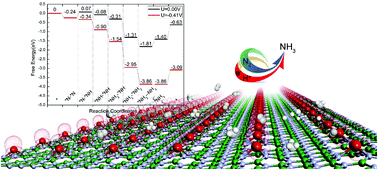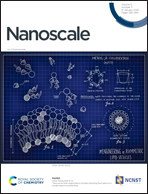Theoretical screening of efficient single-atom catalysts for nitrogen fixation based on a defective BN monolayer†
Abstract
The electrocatalytic reduction of naturally abundant N2 to NH3 is an attractive approach to replace the Haber–Bosch nitrogen-fixation process that causes enormous energy consumption and greenhouse gas emissions. However, designing high-performance catalysts toward the electrocatalytic N2 reduction reaction (eNRR) remains one of the greatest challenges in this area. Herein, high-throughput screening of catalysts for the NRR among a series of transition metal atoms supported on a defective hexagonal boron nitride (h-BN) nanosheet is performed through spin-polarized density functional theory (DFT) computations. Strikingly, among the 18 candidates, the V/Tc atom anchored on a defective h-BN monolayer (V@BN and Tc@BN) showed good NRR activity with relatively low onset potentials. Particularly, V@BN was found to exhibit outstanding catalytic activity for the NRR via an enzymatic pathway with an extremely low overpotential of 0.25 V. The value is significantly lower than that on the Ru (0001) stepped surface that has the best NRR catalytic performance among bulk metal catalysts. The novel NRR activity of V@BN is attributed to the enhanced electrical conductivity due to V-doping, the “donation–backdonation” process for N2 activation, and the highly centralized spin-polarization on the V atom. This work not only provides a quite promising catalyst for the NRR but also provides new insights for the rational design of single-atom NRR catalysts.

- This article is part of the themed collections: Editor’s Choice: Computational studies of nanomaterials for energy, catalysis and electronics and Editor’s Choice: Single-atom and nanocluster catalysis


 Please wait while we load your content...
Please wait while we load your content...